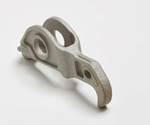Linear Motor Platform Delivers Speed, Low Part Cost for Production AM
Essentium’s additive manufacturing machine based on semiconductor manufacturing has as much in common with precision machine tools as with other FFF 3D printers.
Share
For additive manufacturing (AM) to succeed as a solution for scale production, two conditions will need to be met, says Blake Teipel, CEO and cofounder of Essentium. First, the unit cost of parts made this way will need to be low, and second, the machines will need to be repeatable and reliable. These are the conditions CNC machine tools meet. And these are the requirements the Austin, Texas-based startup had in mind in developing its new High Speed Extrusion (HSE) polymer AM machine. Resembling a machine tool more than a 3D printer, the machine made its North American debut at the recent Additive Manufacturing Users Group (AMUG) Conference.
The printing method for this machine is fused filament fabrication (FFF), common among 3D printers. However, the motion platform is very different, based instead on machines for manufacturing semiconductors. Linear motors with 3G acceleration provide X and Y motion, while ballscrews provide the controlled descent of the build surface in Z. Combined with an extrusion system and proprietary nozzle said to heat from 20 to 500˚C in 3 seconds, the result is a build speed dramatically faster (10 times faster, per the company) than what is conventionally expected of FFF.
That fast build speed is about much more than production rate, Teipel says. Speed is what delivers low cost per part. Meanwhile, the machine-tool-quality motion control components provide for precision and reliability.
The speed is fast enough that the control over heating is crucial. Extrusion heat is varied in coordination with machine motion, essentially as another axis. Otherwise, far more heat would accumulate in the corners, where motion briefly ceases, than along the continuous lines of the build where the part traverses through the heat of the nozzle quickly.
The machine design also anticipates likely production use, Teipel says. The machine’s ballscrew placement leaves clearance for potential automation, including the option to reach into the machine (perhaps through an opening in the side) to collect parts as they are completed.
Our Additive Manufacturing Conference in Austin on August 27-29 includes a visit to Essentium. Learn more at additiveconference.com.
See the video from the AMUG conference, which includes a glimpse of Essentium’s production-speed 3D printer in motion:
Related Content
-
VulcanForms Is Forging a New Model for Large-Scale Production (and It's More Than 3D Printing)
The MIT spinout leverages proprietary high-power laser powder bed fusion alongside machining in the context of digitized, cost-effective and “maniacally focused” production.
-
How Norsk Titanium Is Scaling Up AM Production — and Employment — in New York State
New opportunities for part production via the company’s forging-like additive process are coming from the aerospace industry as well as a different sector, the semiconductor industry.
-
This Drone Bird with 3D Printed Parts Mimics a Peregrine Falcon: The Cool Parts Show #66
The Drone Bird Company has developed aircraft that mimic birds of prey to scare off problem birds. The drones feature 3D printed fuselages made by Parts on Demand from ALM materials.















